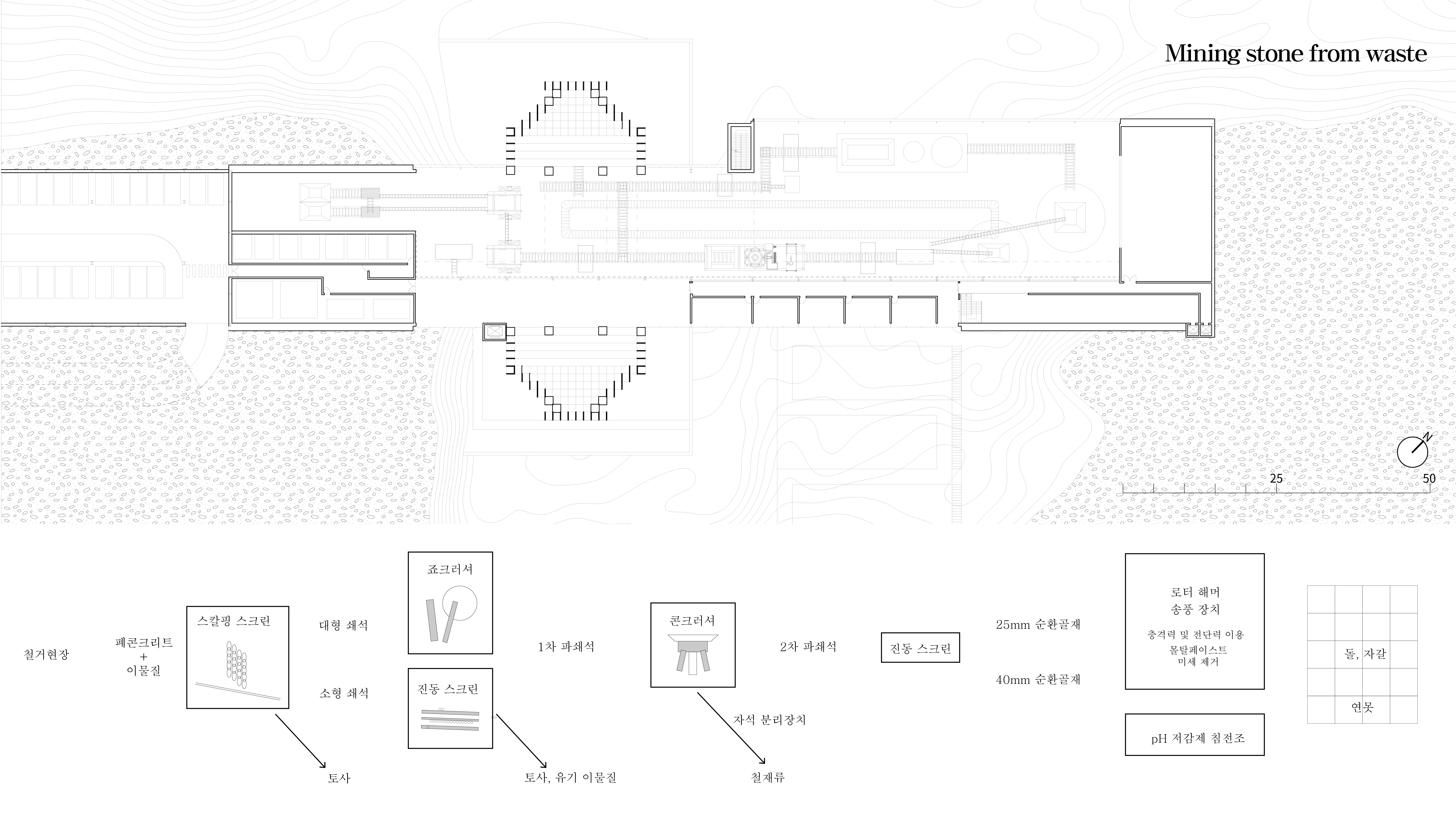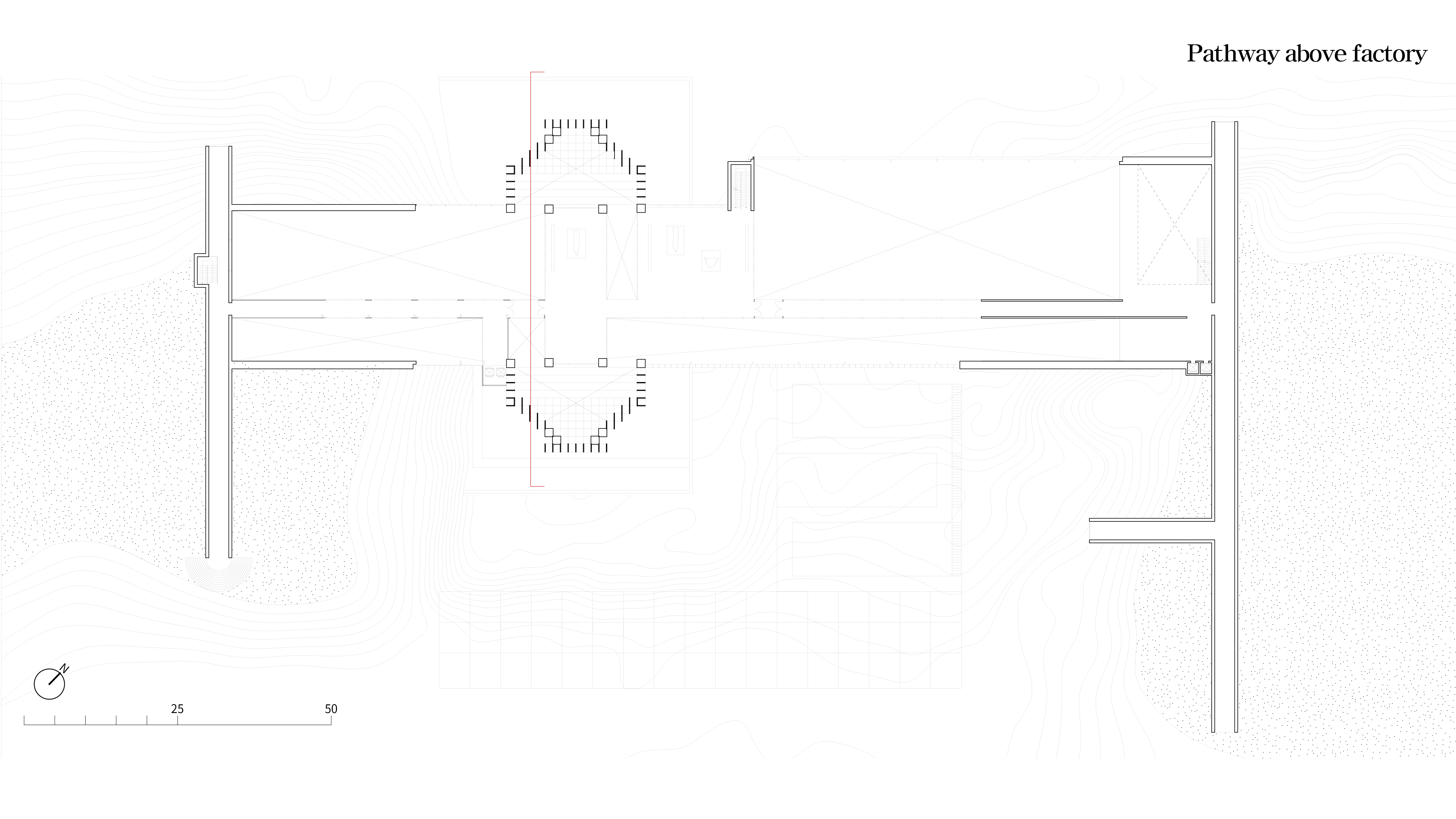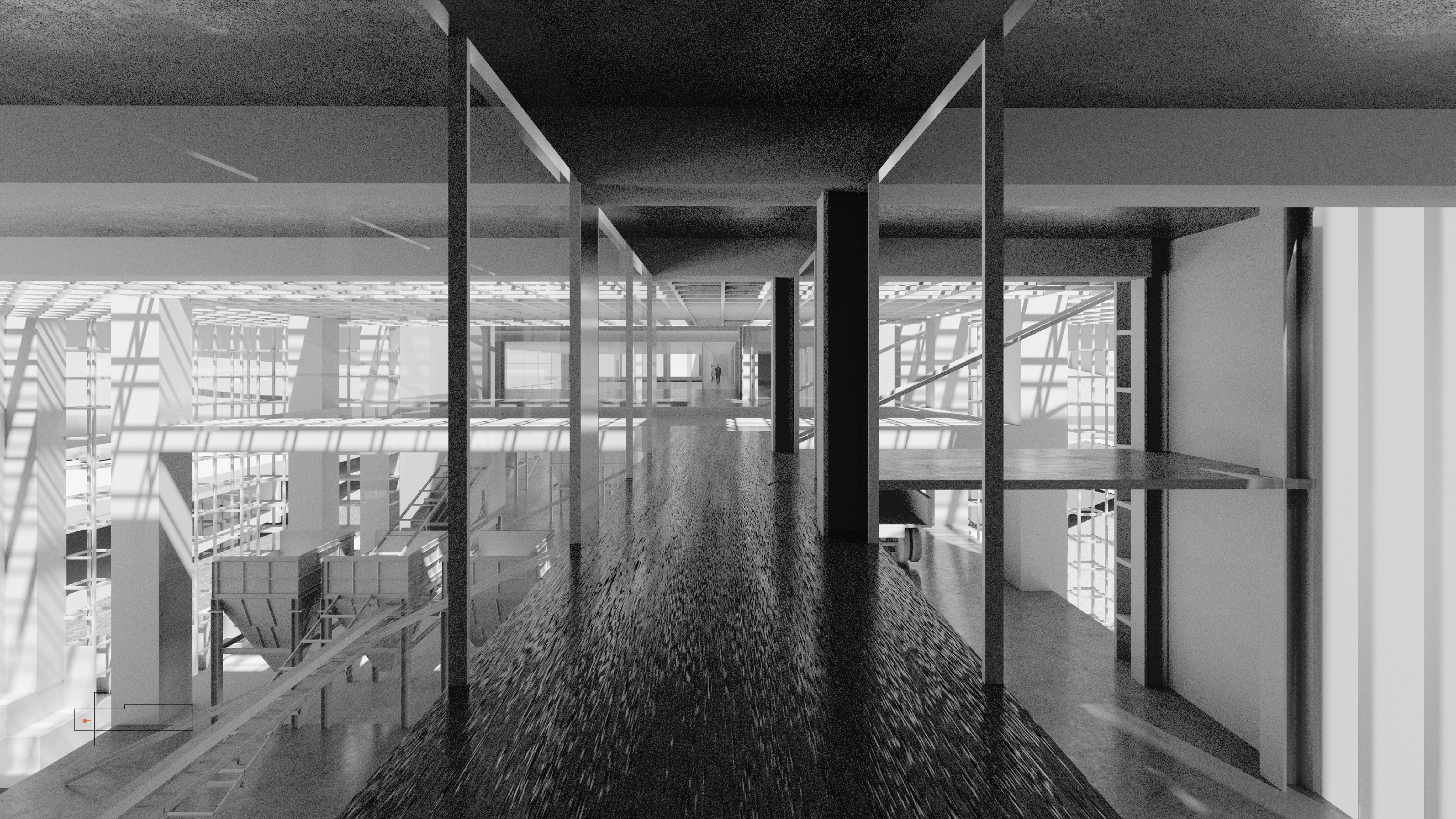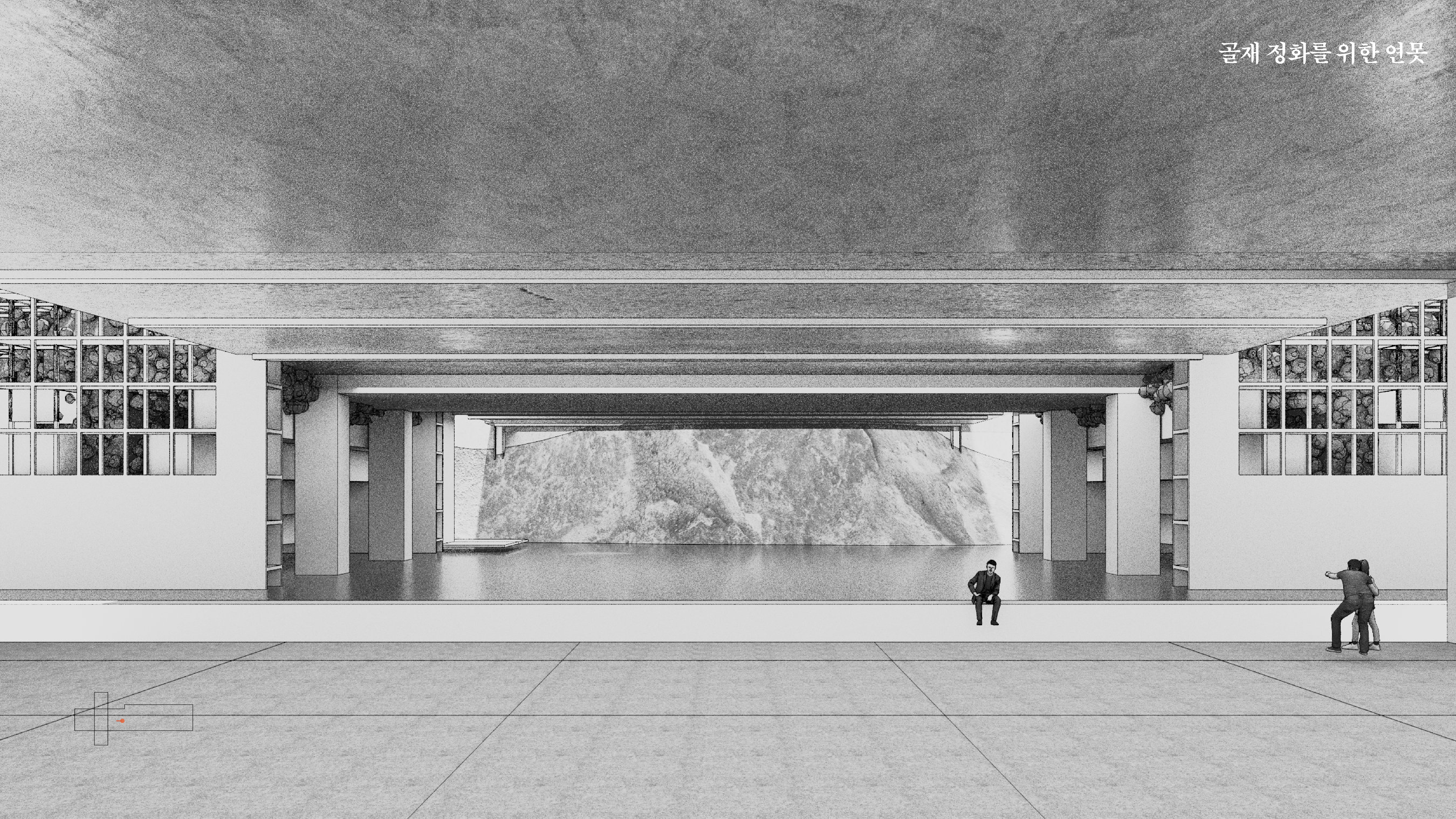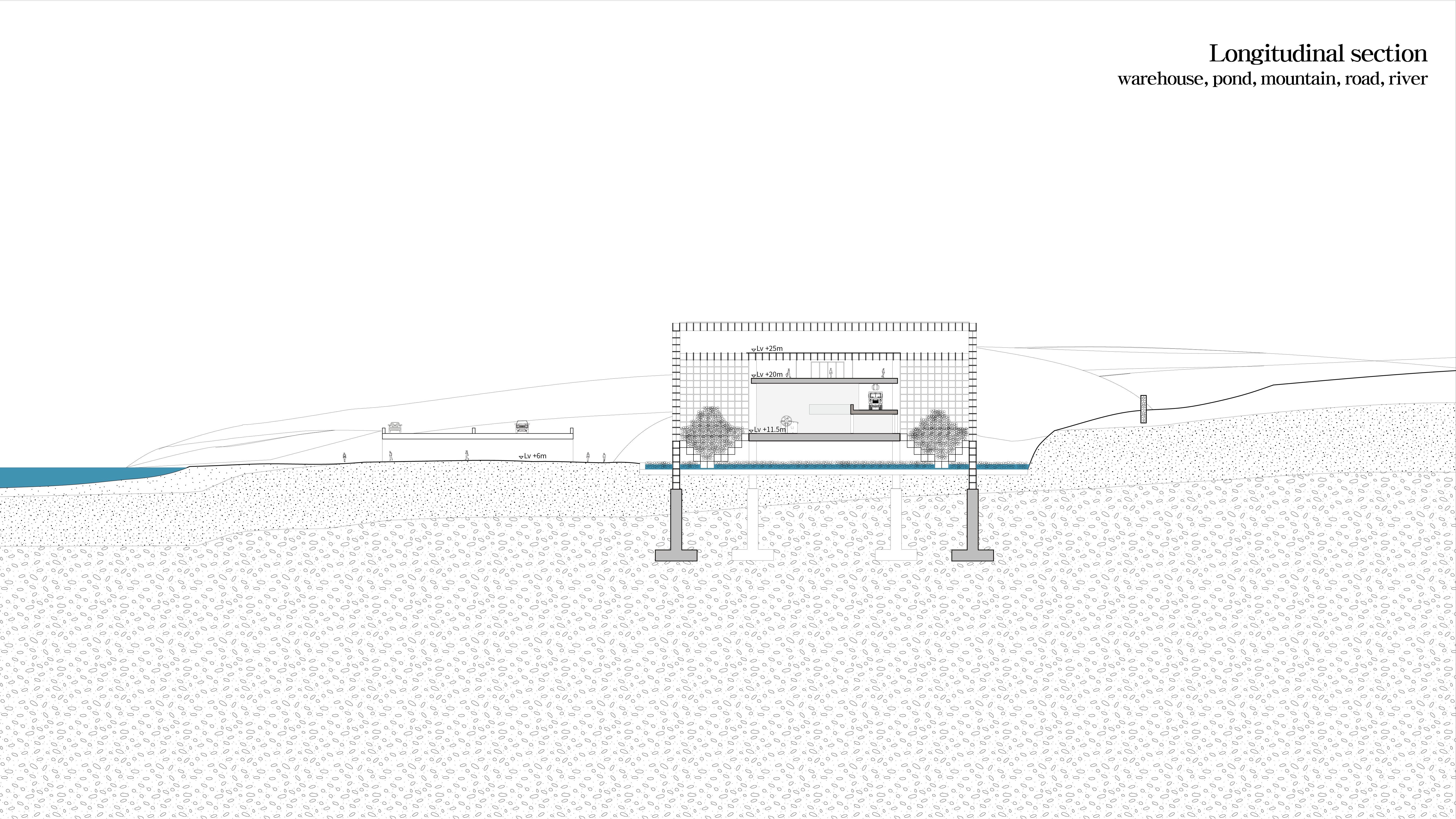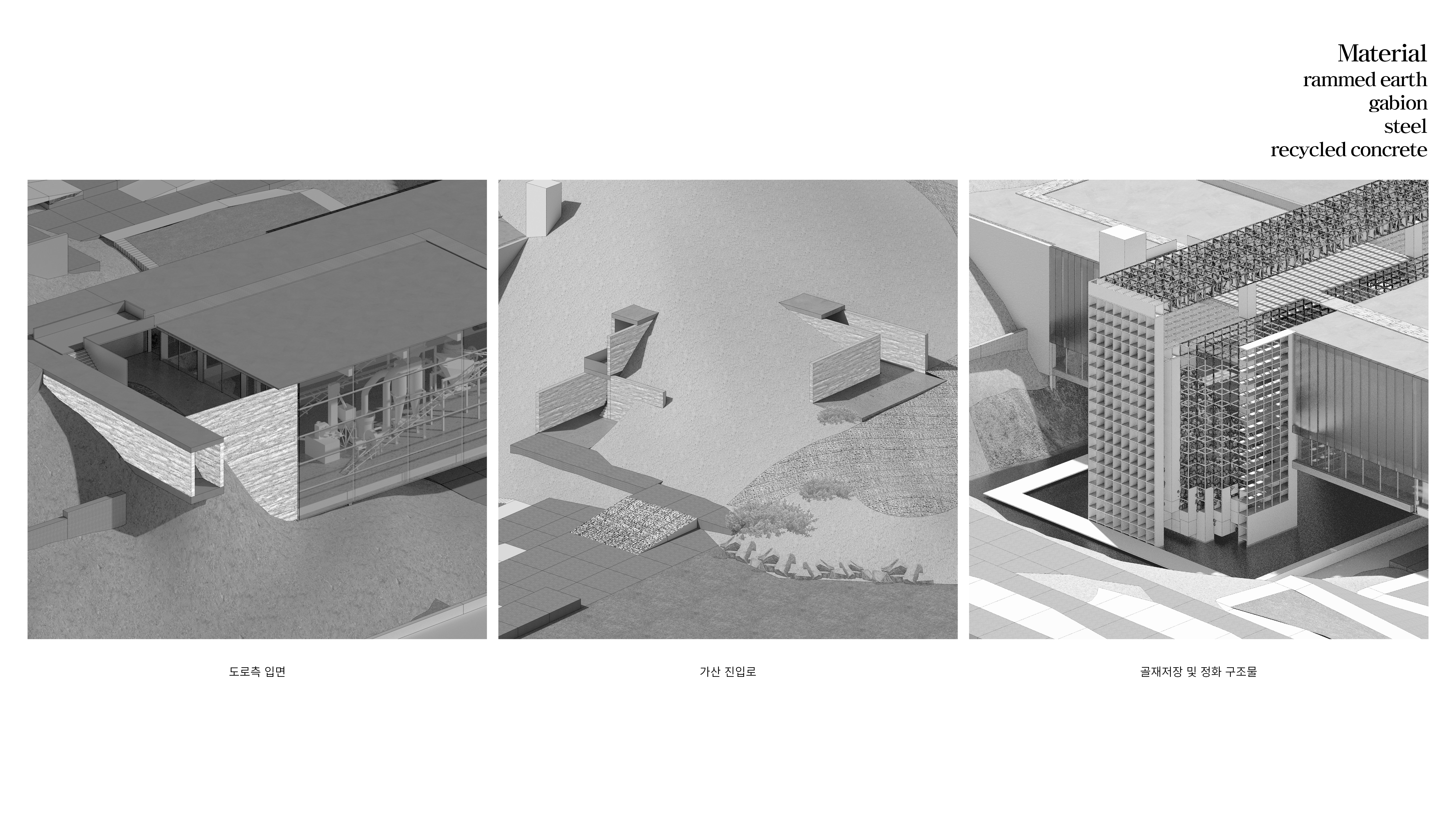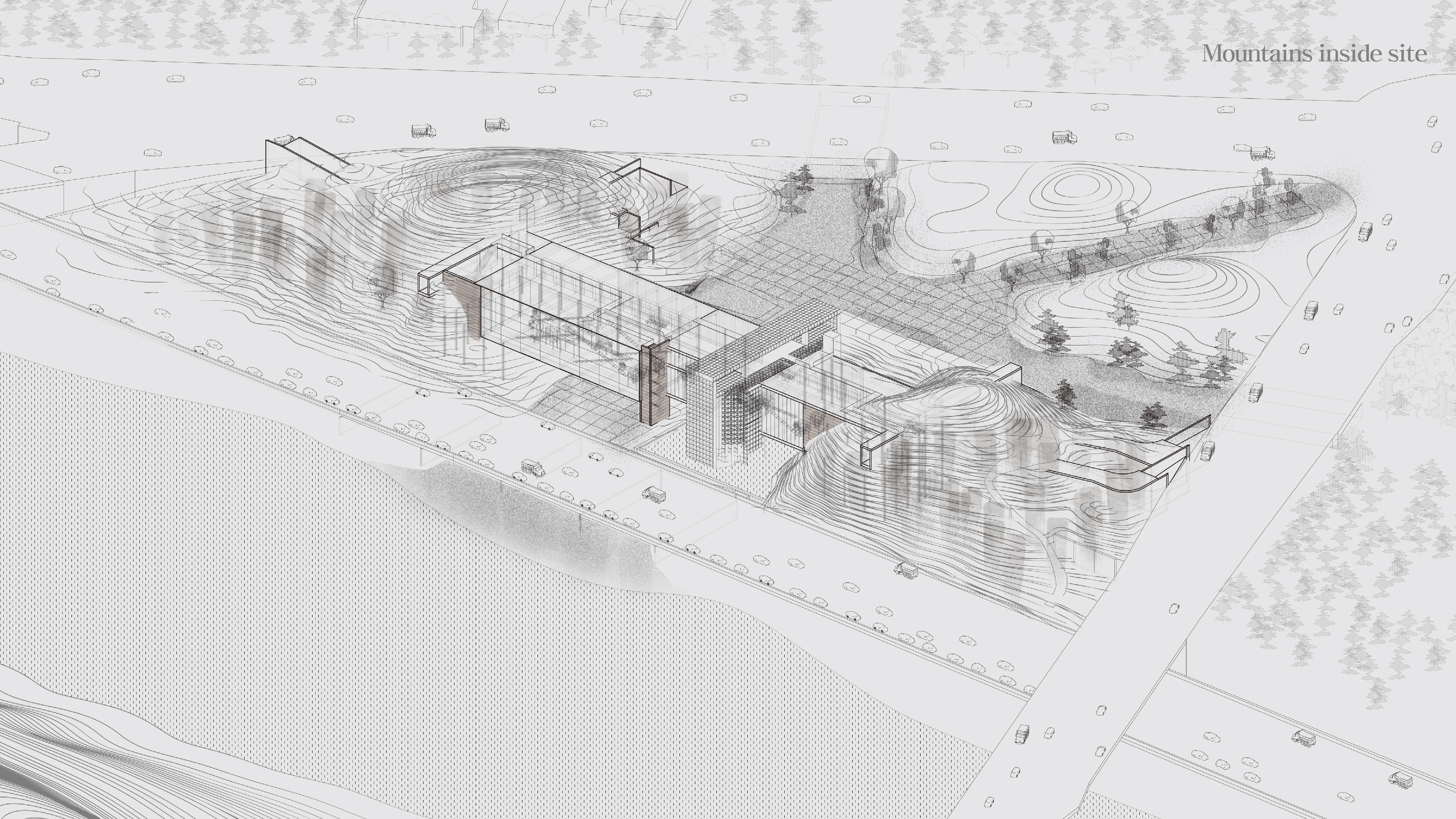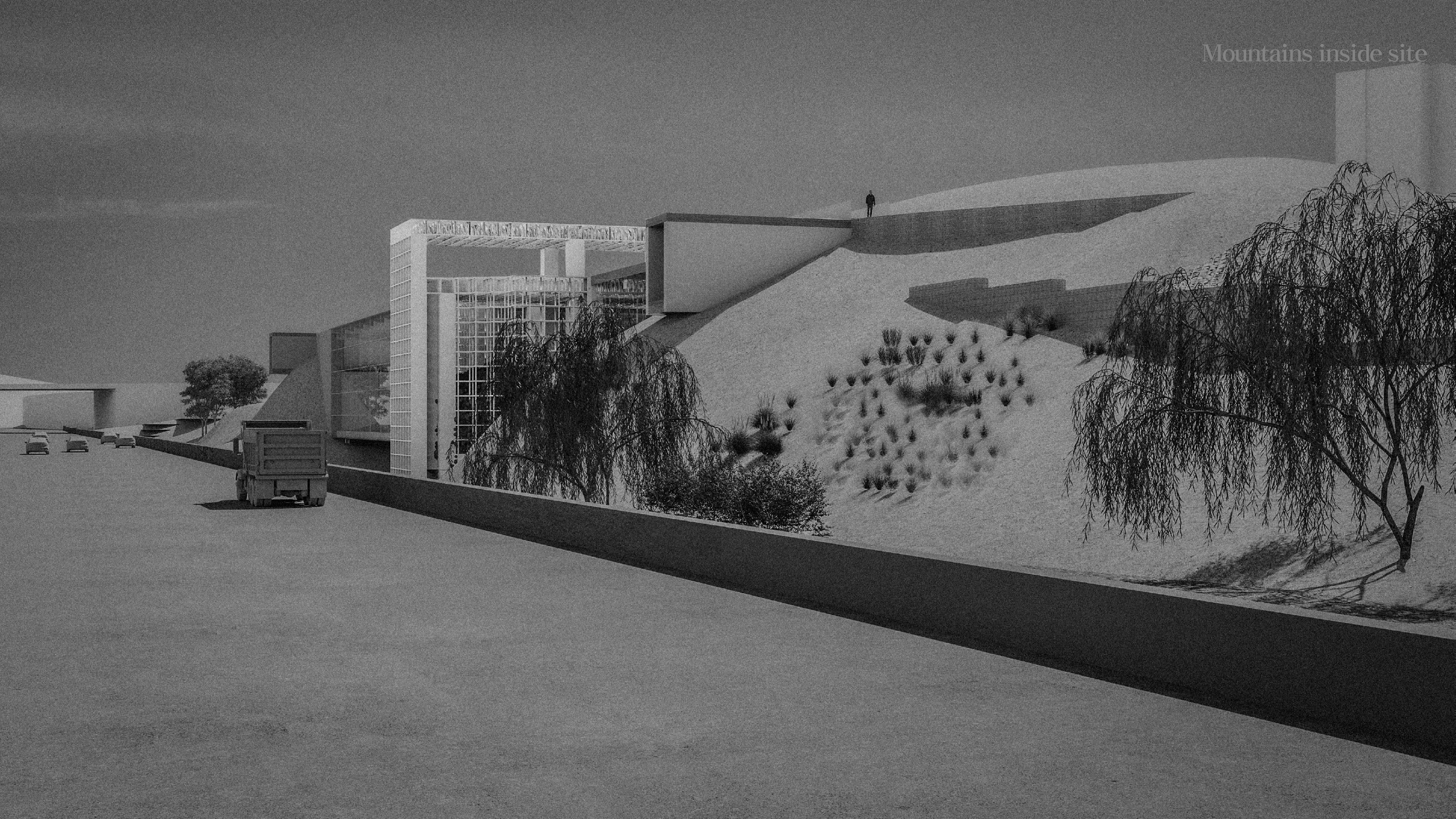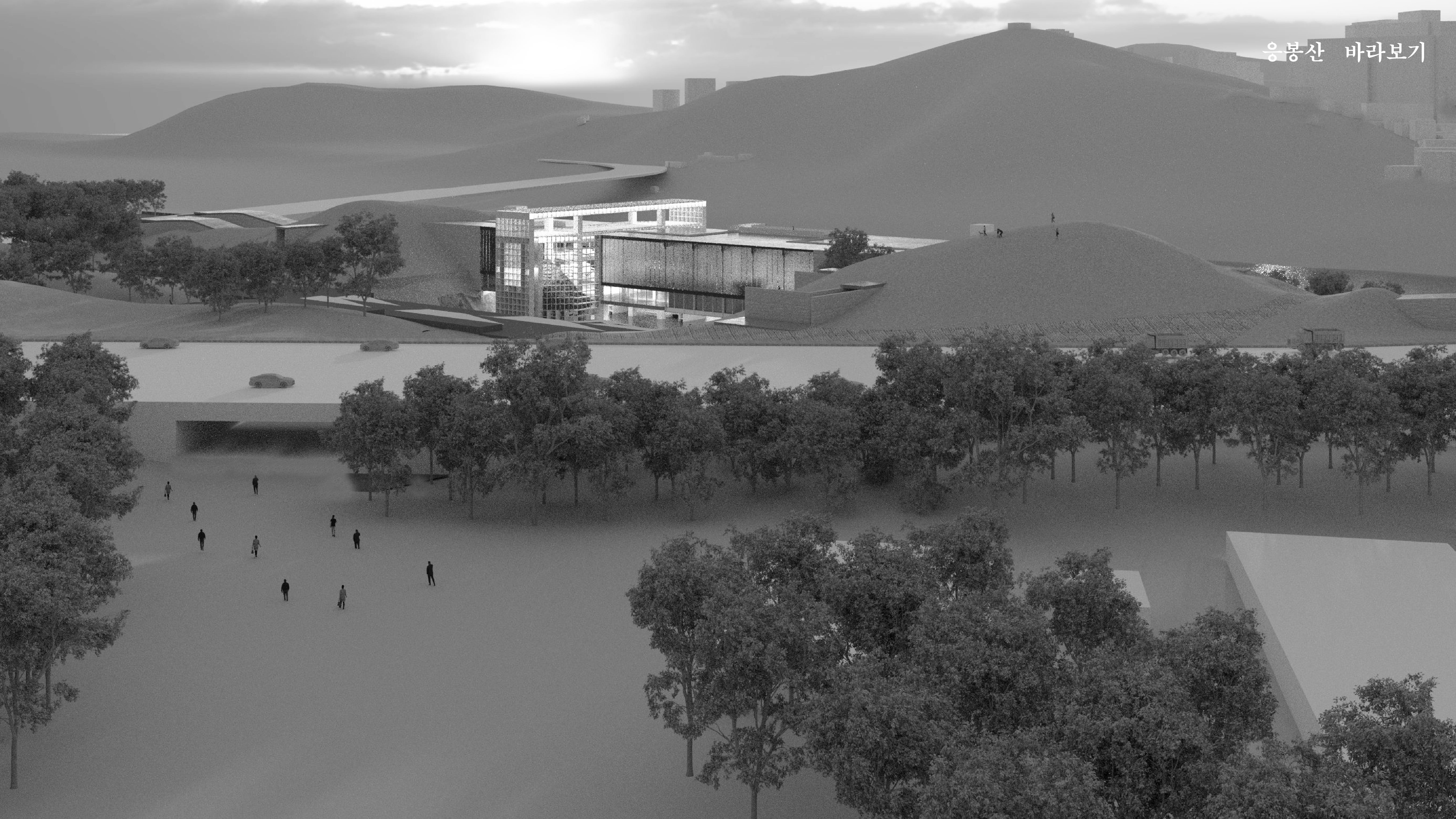조동현_Seoul is Concrete
인간-비인간 네트워크
콘크리트에 사용되는 골재라는 비인간 행위자는 행위자이기 이전에 평범한 돌에 불과하다. 비인간이란 인간이 아닌 무엇이다. 그리고 인간은 비인간과도 상호작용을 한다. 건축가를 인간 행위자로 설정했을 때 셀 수 없을 정도의 비인간과 연결되는데, 예를 들면 콘크리트, 나무, 돌, 등의 건축 재료들이 비인간으로서 건축가와 연결돼있는 것이다. 건축 재료는 자연에서 채취할 수 있는 것으로 주로 구성된다. 그 중 콘크리트는 시멘트와 골재 그리고 혼화물 등이 섞여 만들어지는 재료이다. 이중 시멘트는 석회석으로부터 만들어지고, 골재는 산이나 강 바다에서 구할 수 있는 자갈이나 모래이다. 이 프로젝트에서는 한강에 있었던 자갈, 모래를 중심으로 네트워크를 형성하여 이와 연관되어 있는 비인간들에 의미를 부여하며 행위자로 설정한다.
서울의 개발, 한강의 기적
서울은 한강 이라는 거대한 비인간과 함께 도시의 구실을 갖추게 된 곳이라고 해도 과언이 아니다. 1970년대 인구가 폭증하며 주택난을 해결하기 위해 한강에서 퍼 올린 골재로 콘크리트를 만들어 집을 지었다. 골재를 채취하기 위해 골재 사업 공장이 생겼고, 콘크리트를 사용될 위치까지 운반하기 위해 레미콘 공장이 들어서 가동되었다.
레미콘 공장이 쌓은 업적
한강과 중랑천이 만나는 지점에 세워진 삼표 레미콘 성수 공장은 46년 동안 레미콘을 생산하였는데 그 양이 약 4,600만 루베에 달한다. 이는 24평형 아파트를 200만 가구 지을 수 있는 정도의 양이다. 레미콘 공장이 열심히 가동된 덕분에 지금의 서울과 한강이 만들어지게 되었고, 이는 인간 중심의 경관을 만들었다고도 볼 수 있다. 서울이 도시로서 원활하게 기능할 수 있도록 해 준 것이다. 지난 46년간 이 공장의 역할이 레미콘의 단계를 거쳐 콘크리트를 만들어 ‘짓는다’는 행위에 초점이 맞추어져 있었다면 앞으로 50년간은 ‘부순다’혹은 ‘되돌린다’에 초점을 맞추어야 한다고 생각한다.
자본의 논리로 바라본 대상지
자연과 골재가 아닌 ‘자본’의 입장에서 성수동 레미콘 공장을 바라봐보자. 소규모 공장과 경마장 외에 별다른 것이 없었던 곳이었다. 하지만 주변이 개발 되면서 점차 교통의 요충지에 존재하는 도심지가 되었다. 교통이 좋은 곳이기 때문에 상업용도, 관광용도, 오피스용도로 사용되는 것이 효율적이고 자본의 순환에도 긍정적이라 볼 수 있다. 공장은 없어지고 도시민들이 방문하여 소비하고 경제활동을 하는 곳이 되는 것이 맞다. 하지만 이 프로젝트에서는 자본이 아닌 골재와 콘크리트가 해왔던 행위의 연장선에서 이 공장을 바라보고자 하는 것이다.
서울의 요구사항
서울에서 발생하는 건설폐기물들은 서울 밖으로 이동하여 처리된다. 중간처리업체 등의 폐기물 처리 시설들은 거주하는 곳 가까이에 있으면 안된다는 편견에서 벗어나고자 한다. 가장 바람직한 방향은 누구나 알고 있듯이 더 이상 지어지지 않는 방향이다. 하지만 이미 서울은 콘크리트로 뒤덮여 있으며 그 중 대부분의 콘크리트는 사용기한을 가진다. 언젠가는 부수어 폐기물이 되어야 하고 그 자리에는 새로운 콘크리트가 들어가게 된다. 서울에 쌓여있는 콘크리트를 전부 걷어내는 방향으로 가야 한다는 것이 아니라 콘크리트의 속성을 연구해서 그것의 순환과정에 개입한다는 것이다.
도시경관
사이트와 맞닿아 있는 동부간선도로는 중랑천과 서울숲을 분리하고 있다. 동부간선도로 밑을 파내어 파낸 흙은 다시 사이트에 쌓아 가산을 만들고, 공장또한 가산을 통해 들어올려 밑으로의 통행이 가능하게 한다. 이는 가산에서부터 강으로 이어지는 우수의 흐름도 의도한다.
미래의 사이트가 해야 할 일과 부여되는 과제
폐콘크리트는 순환골재로 파쇄되어 재활용 될 수 있다. 순환골재를 생산하는 거대한 기계를 놓음으로서 건설 폐기물 재활용에 기여하고 이 순환골재가 다시 건설재료로만 쓰이는 것이 아니라 조경이나 그 외 한강의 경관을 변화시킬 수 있는 곳에 쓰일 수 있도록 한다. 시각적으로도 가산과 공장의 거대한 규모를 통해 폐콘크리트의 양이 얼마나 방대한지를 직접 느낄 수 있는 곳을 디자인하고자 하였다.
Human-Nonhuman Network
Aggregates used in concrete are just ordinary stones before they become actors. Nonhumans refer to anything that is not human. Humans interact with nonhumans as well. When architects are considered human actors, they are connected to countless nonhumans, such as concrete, wood, and stone, which are building materials. These building materials are primarily sourced from nature. Among them, concrete is made by mixing cement, aggregates, and admixtures. Cement is produced from limestone, and aggregates are gravel or sand obtained from mountains, rivers, or seas. This project focuses on forming a network around the gravel and sand that once existed in the Han River, assigning meaning to these nonhumans and setting them as actors.
The miracle on the Han River and Seoul’s development
It is no exaggeration to say that Seoul developed into a functioning city alongside the enormous nonhuman entity known as the Han River. In the 1970s, to solve the housing shortage caused by a population explosion, concrete was made using aggregates extracted from the Han River, and houses were built. Aggregate businesses emerged to extract these materials, and ready-mix concrete plants were established to transport the concrete to construction sites.
Achievements of the Ready-Mixed Concrete Plant
The Sampyo ready-mixed concrete plant, established at the junction of the Han River and Jungnangcheon, produced ready-mix concrete for 46 years, totaling about 46 million cubic meters. This quantity is enough to build 2 million 24-pyeong (approximately 79.2 square meters) apartments. The diligent operation of the ready-mix concrete plant helped shape modern Seoul and the Han River, creating a human-centered landscape that enabled Seoul to function smoothly as a city. While the plant's role over the past 46 years focused on the act of 'building' through concrete production, it is now time to focus on 'demolishing' or 'restoring' over the next 50 years.
Viewing the Site from the Perspective of Capital
Let's examine the Seongsu-dong ready-mix concrete plant from the perspective of 'capital' rather than nature or aggregates. Initially, the area had nothing but small factories and a racetrack. However, as the surroundings developed, it became a crucial urban area with excellent transportation. Due to its favorable location, it is efficient to use the area for commercial, tourism, or office purposes, which would positively impact capital circulation. The factory should be removed to become a place where urban residents visit, consume, and engage in economic activities. However, this project aims to view the plant through the extension of the actions performed by aggregates and concrete, not capital.
Seoul’s Requirements
Construction waste generated in Seoul is transported outside the city for processing. This project seeks to break away from the prejudice that waste processing facilities, such as intermediate processing companies, should not be close to residential areas. Ideally, as everyone knows, the best direction is to stop building further. However, Seoul is already covered in concrete, most of which has a lifespan. Eventually, it will have to be demolished and replaced with new concrete. This does not mean removing all the concrete in Seoul, but rather studying its properties and intervening in its recycling process.
Urban Landscape
The Dongbu Expressway, adjacent to the site, separates Jungnangcheon and Seoul Forest. Excavating beneath the expressway and using the soil to create an artificial hill on the site will allow the factory to be elevated, enabling passage underneath. This design also intends to manage rainwater flow from the hill to the river.
Future Tasks and Challenges for the Site
Waste concrete can be crushed and recycled into recycled aggregates. By installing large machines to produce recycled aggregates, the site can contribute to recycling construction waste. These recycled aggregates can be used not only as construction materials but also in landscaping and other areas to transform the Han River’s landscape. The design aims to visually convey the vast amount of waste concrete through the large scale of the hill and the factory, creating a place where this magnitude can be directly experienced.







